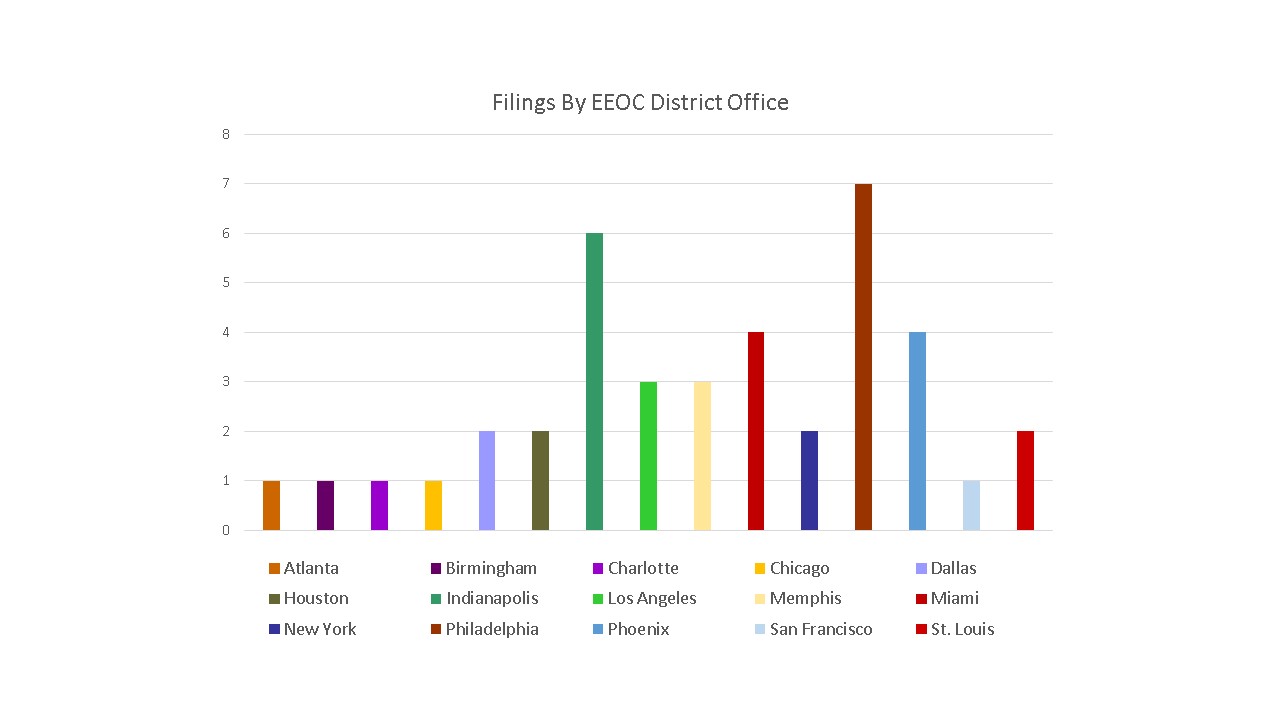By: Gerald L. Maatman, Jr., Jennifer A. Riley, and Alex W. Karasik
Duane Morris Takeaways: In FY 2022, September was a busy month for EEOC-Initiated litigation. In FY 2021, the EEOC’s litigation enforcement activity showed signs of recovering from the lingering COVID-19 pandemic and the total number of case filings increased from the low of 33 in 2020, giving rise to what was anticipated to be a very busy FY 2022. True to its pre-COVID history, the EEOC ended its year with a surge of last-minute lawsuits.
This year, there were 39 lawsuits filed during September as of the publishing of this blog post (down from the 59 filed in September of FY 2021, however, it constituted a significant increase from 2020).
Cases Filed By EEOC District Offices
In addition to tracking the total number of filings, we closely monitor which of the EEOC’s 15 district offices are most actively filing new cases this September. Some districts tend to be more aggressive than others, and some focus on different case filing priorities. The following chart shows the number of lawsuit filings by EEOC district office.
The most noticeable trend of FY 2022 is the filing dip in some key regions compared to past years. The New York district office had 6 filings in FY 2021 and only 2 in 2022. The California district offices in San Francisco and Los Angeles, which combined for 13 new filings last year, declined in FY 2022, falling to only 4 total filings, including San Francisco’s fall from 6 to 1. The Indianapolis district office was in the middle of the pack with 4 filings this year. Philadelphia led the way in FY 2022 with a total of 7 filings. Miami and Phoenix also had 4 each, Memphis had 3, and Dallas, Houston, and St. Louis all had 2 total filings.
Analysis Of The Types Of Lawsuits Filed In FY 2022
We also analyzed the types of lawsuits the EEOC filed throughout the month, in terms of the statutes and theories of discrimination alleged, in order to determine how the EEOC is shifting its strategic priorities.
When considered on a percentage basis, the distribution of cases filed by statute in September remained roughly consistent compared to FY 2021 and FY 2020. Title VII cases once again made up the majority of cases filed, making up 69% of all filings (a bit higher than the 62% in FY 2021 and 60% in FY 2020). ADA cases also made up a significant percentage of the EEOC’s September filings, totaling 18%, although down from the 36% in FY 2021. There were also 3 ADEA cases filed in September, after only one age discrimination case filed in the entire FY 2021.
The graphs below show the number of lawsuits filed according to the statute under which they were filed (Title VII, Americans With Disabilities Act, Pregnancy Discrimination Act, Equal Pay Act, and Age Discrimination in Employment Act) and, for Title VII cases, the theory of discrimination alleged.
March 2022 Release Of Enforcement Statistics
On March 28, 2022, the EEOC released its fiscal year 2023 budget justification and fiscal year 2021 performance report (“APR”). The APR is a review of the results of the EEOC’s litigation goals and performance from FY 2021 and the FY 2023 budget describes how funds will be allocated. The EEOC put out a proposed 2023 budget of $464,650,000.
FY 2021 APR
The APR described a successful year in the EEOC’s eyes in terms of delivering on its strategic initiatives, including securing $485 million in monetary relief for over 15,000 alleged victims of employment discrimination, resolving a total of 138 merit lawsuits, reducing the inventory of appellate cases by 9.1%, and have a significant percentage of its resolutions in district courts achieve a “favorable result.” Comparing the monetary recovery to previous years, the EEOC recovered $535.5 million in FY 2020, $486 million in FY 2019, and $505 million in FY 2018.
The EEOC also continued working towards its goals in community outreach, education, and technical assistance, and hired predominate front-line positions.
FY 2023 Budget Justification
Moving into 2023, the EEOC’s budget constitutes a $60.160 million increase from 2021, and focuses on three key areas including providing racial justice and eliminating systemic discrimination of all protected bases, pay equity, and the civil rights impact of the COVID-19 pandemic. The EEOC also announced three new programs, including the Hiring Initiative to Reimagine Equity (HIRE), which aims to expand employment opportunities as the nation recovers from the pandemic; a joint anti-retaliation initiative with the U.S. Department of Labor and the National Labor Relations Board; and an initiative to ensure that employment-related artificial intelligence and algorithmic decision-making tools comply with federal civil rights laws.
Key Employer Takeaways
FY 2022 was a year of new leadership and structural changes at the EEOC. With a vastly increased proposed budget, it is more crucial than ever for employers to take heed in regards to the EEOC’s strategic priorities and enforcement agendas.





